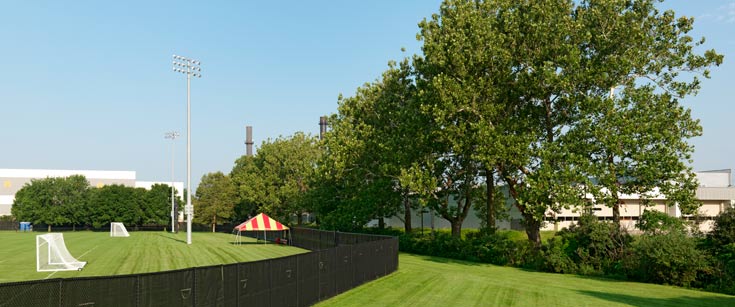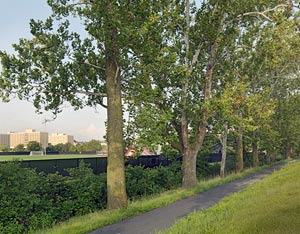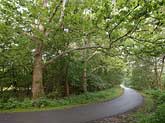

Photograph © David Jordano
Professor of Horticulture A.T. Erwin and Superintendent of Grounds for the College planted this row of 50 sycamore trees (Platanus occidentalis) parallel to the Ames-to-Campus Railway in the early 1900s. The path, originally one of the routes for pioneer migration through the Midwest, now connects the town to the college. The tracks for the old steam engine and electric trolley have disappeared and the cinder crunch has been paved over with asphalt, but the trees still stand. The City of Ames is set to replace a pedestrian bridge across Squaw Creek immediately north of the sycamore row endangering those trees closest to the construction.
History
(top) The newly planted sycamore trees in 1917;
(bottom) A student traverses the Ames-to-campus
path beneath the mature sycamore trees in 2010.
Courtesy Deb Cooper
Iowa State Agricultural College (now called Iowa State University) was established in 1860s as one of the country’s first land-grant colleges. During the early 1900s, Horticulture Professor and Superintendent of Grounds A.T. Erwin oversaw plantings throughout the Iowa State University campus. As part of this beautification project, he had 50 sycamore trees (Platanus occidentalis) installed in a nearly one mile-long row parallel to the Ames-to-Campus Railway.
The railway path was originally one of the routes pioneers used as they migrated through the Midwest. After the college was established, the Dinkey, as students came to call the train line, connected the town to the college and carried faculty, staff, and students to campus. The Dinkey made its first run July 4, 1891. An electric trolley replaced the steam locomotive in 1907 and, in 1909, the Faculty Public Grounds Committee approved Erwin’s request to plant the row of sycamore trees along the old cinder path that ran parallel to the railway. By 1929, buses and personal vehicles usurped the train’s passenger service. The tracks remained in place for a period of time so supplies could be transported to the campus by rail. However, by the late 1930s, the tracks gradually began to disappear from the campus.
In 1993, severe flooding in the region prompted officials to replace a culvert that ran underneath the cinder path east of campus with a larger structure. One of the original trees was lost during construction; its large stump still hugs the bank along the channel.
Today, 42 of the original trees still stand and 5 of those that were lost have been replaced with similar, more disease and fungus resistant sycamores (Platanus acer 'bloodgood’). While the tracks for the old steam engine and electric trolley have disappeared and the cinder crunch has been paved with asphalt, the sycamore trees continue to map the path used by countless pioneers as they traversed the country.

Photograph © David Jordano
Threat
In 2009, the university rerouted and upgraded utility lines running parallel to the sycamore row. Engineers cut a wide culvert to Squaw Creek through the floodplain woodlands immediately south of these trees. The City of Ames is now set to replace the old pedestrian bridge across Squaw Creek immediately north of the row of trees. While formal plans have yet to be released, the proximity of the project to the trees means construction will likely affect the trees or require removal of the ones closest to the bridge.


